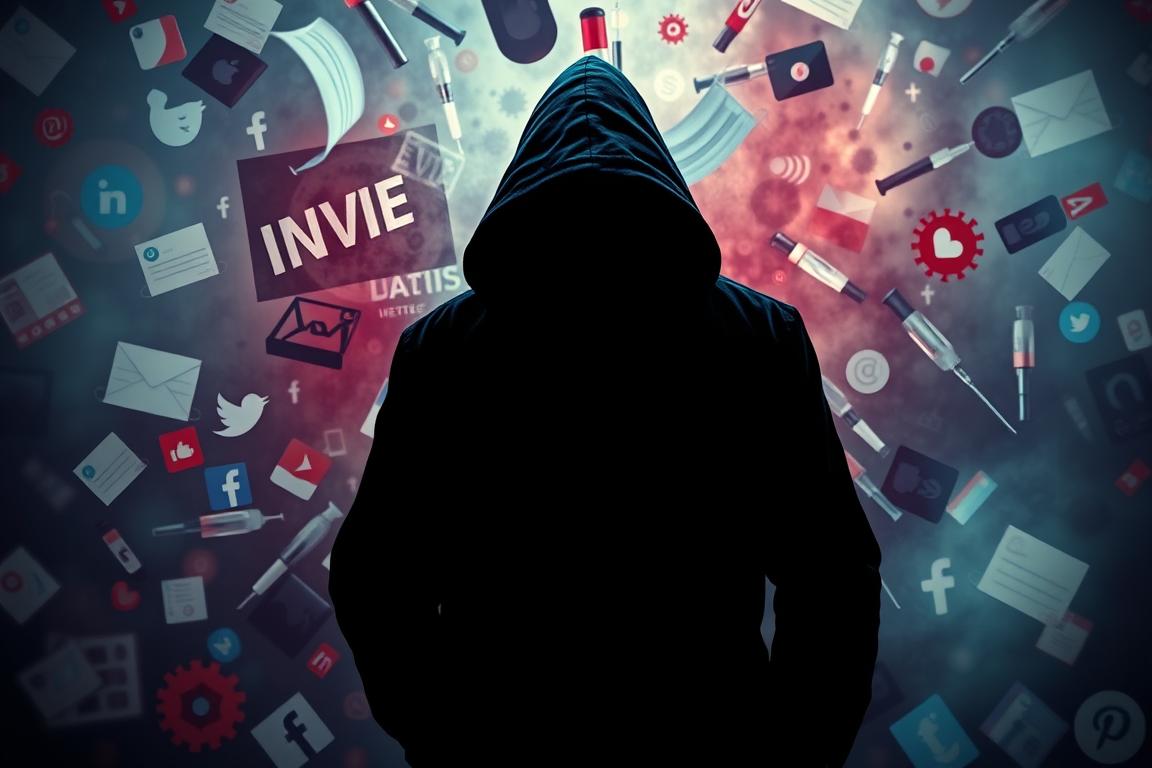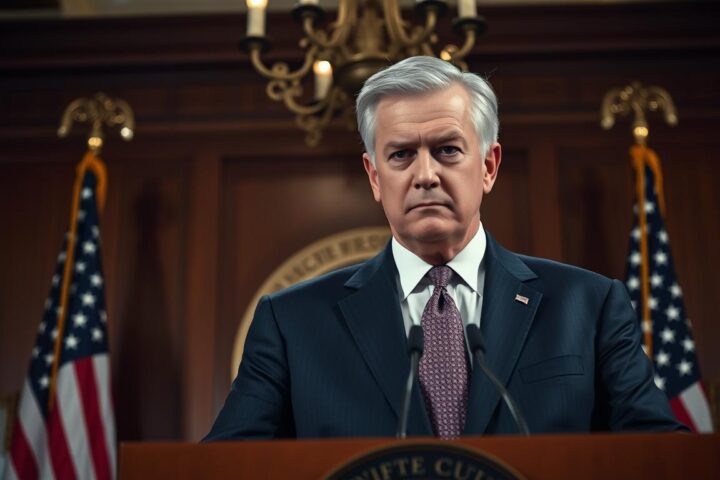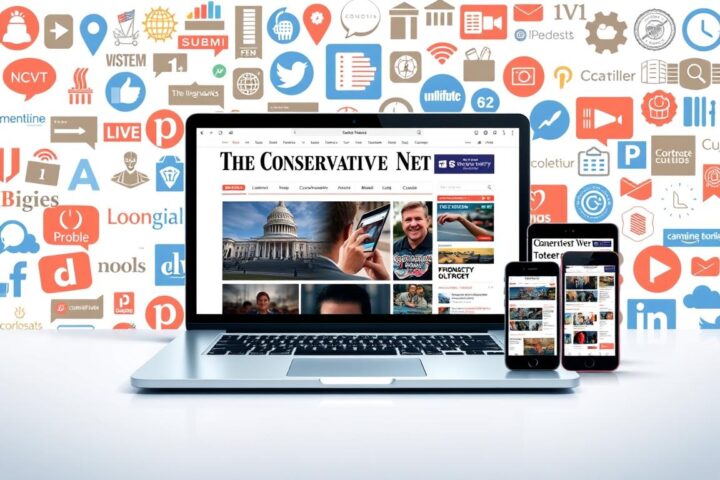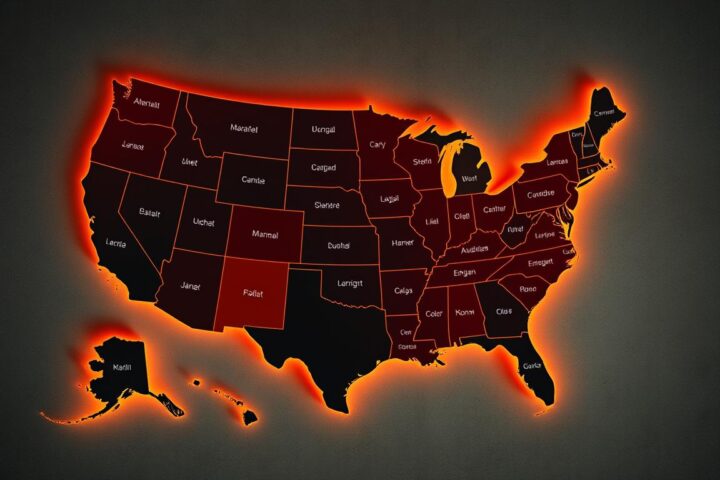COVID-19 has left a lasting impact on our world. We’re left wondering: How much truth was in what Dr. Anthony Fauci and others told us? A new COVID-19 movie aims to shed light on the COVID-19 lies linked to Fauci. It challenges common beliefs in a growing public health controversy.
Over 1.1 million Americans have lost their lives to the virus. Millions more have been affected. The effects of these coronavirus misinformation campaigns are huge1. This article explores the pandemic’s origins and Fauci’s policies. It sets the stage for a deep look into accountability and truth in public health.
Key Takeaways
- The COVID-19 movie reveals alleged lies by Dr. Fauci regarding the pandemic’s origins.
- Over 1.1 million Americans have died from COVID-19, with a significant impact on society.
- Claims suggest the virus may have originated from a Chinese lab funded by the U.S. government.
- Dr. Fauci’s changing statements raise questions about transparency in public health.
- The National Institutes of Health’s role in funding research has come under scrutiny.
- Understanding the origins of COVID-19 is crucial for accountability and future prevention.
Introduction: The Controversy Surrounding Dr. Fauci
Dr. Anthony Fauci’s role in the COVID-19 pandemic has sparked a lot of debate. As the head of the National Institute of Allergy and Infectious Diseases, he helped shape national policies. However, his actions have made him a divisive figure, caught in the Dr. Fauci controversy.
People have different views on Dr. Fauci’s decisions. His efforts to slow the virus’s spread have worked in some places but faced criticism elsewhere. This shows the struggle between following scientific advice and keeping personal freedoms.
His leadership style has raised questions about openness and responsibility. Critics say we need honest talks about government responses and health rules’ impact on freedom. Supporters see him as a champion of science, while others see him as a sign of government too much power.
The story of Dr. Fauci shows the hard balance between expert advice and public trust. Many Americans want clear answers during the pandemic. Misinformation adds to the problem, making it hard to understand how to manage COVID-19. Looking ahead, it’s crucial to understand how his decisions affect society and health policy23.
Understanding the Origins of COVID-19
The COVID-19 pandemic is one of the deadliest diseases in recent times. It is believed that the Chinese virus, known as SARS-CoV-2, came from a β-coronavirus in the sarbecovirus group. It emerged in late 2019 and quickly spread worldwide, becoming the deadliest respiratory disease pandemic since 19184.
Studies show that bats were responsible for over 98% of coronavirus detections in various regions5.
Research suggests the virus might have come from the Wuhan lab, where scientists were studying viruses. Congressional hearings have tried to uncover the truth about the pandemic start and possible cover-ups. They have focused on officials who might have ignored the lab leak theory. The risk of new viruses from such places is still a threat to public health, making better pandemic preparedness and response crucial [source].
Experts say the COVID-19 pandemic shows we need more funding for research. Understanding where COVID-19 came from is key to preventing future crises. This includes transparent investigations into the Wuhan lab and speeding up research on the causes of viral outbreaks46.
Covid 19 Lies: The Narrative We Were Sold
The COVID-19 pandemic has led to many false stories. At first, people thought it was a natural virus. But now, nearly 7 million deaths later, where it came from is a big question7. The Energy Department’s findings on a possible lab leak sparked a huge rise in conspiracy theories7.
This shows how fast false information spreads. It makes people doubt the health experts.
49% of Americans think the virus might have been made by humans8. And 13% believe the whole pandemic is a hoax8. This shows how different people’s views are, thanks to mixed messages.
Dr. Fauci’s change on masks is a good example. He first said masks weren’t needed, then later said they were9. This confusion makes people question health advice.
A tweet claiming masks don’t work and the virus came from a lab got a lot of attention7. The World Health Organization says it’s likely the virus came from animals, but they also want to look into the lab leak theory7. This debate leads to many conspiracy theories, like the virus being a bioweapon from China7.
People are sharing fake news about the virus more and more, with about 35% admitting to it8. This makes it harder to get the real message out about staying safe.
The Recent Congressional Hearing on COVID-19
The recent congressional hearing with Dr. Fauci was a key moment in the COVID-19 debate. He faced tough questions from the House Select Subcommittee on the Coronavirus Pandemic. Dr. Fauci said America’s public health system failed badly in a 14-hour interview, his first since retiring10.
He also said the “six feet apart” rule was not based on science. This sparked a lot of debate about public health policies10.
Funding and research practices were big topics. Republicans questioned funding for virology research in China, suggesting it might have led to the virus. Dr. Fauci denied this, saying no NIH-funded viruses could have turned into SARS-CoV-211.
The hearing was tense, with many questioning Dr. Fauci’s actions and decisions during the pandemic.
Dr. Fauci also talked about the lab leak theory, which he had earlier called a conspiracy. He said he now thinks it’s possible, showing the complexity of his testimony10.
The hearing was emotionally charged. Fauci mentioned getting death threats, which made him and his family need protection11.
The Lab Leak Hypothesis: What We Know
The lab leak hypothesis is getting more attention as new evidence and stories come out. It says COVID-19 might have come from the Wuhan Institute of Virology. The Department of Energy and the Federal Bureau of Investigation think it’s possible12. But, many scientists still believe it came from animals, like SARS-CoV-1 and MERS-CoV13.
Dr. Kristian Andersen said the U.S. funded research at Wuhan that didn’t follow safety rules12. Dr. Anthony Fauci said in Congress that we shouldn’t ignore the lab leak theory. He moved away from saying it was just a conspiracy12.
Proximal Origin, a paper by Fauci and Dr. Francis Collins, supported the zoonotic theory. But, some say they changed their views after talking to officials12. This has raised questions about their motives and if they put politics over science.
This debate makes people question the science behind the zoonotic theory12. It’s important because it affects how we understand COVID-19 and its origins. It also shows the complex relationship between science and politics.
Fundamentals of Gain-of-Function Research
Gain-of-function research (GOFR) is a hot topic in science. It involves changing viruses to see how they spread and harm more. This has raised big questions, especially with the Wuhan Institute of Virology (WIV) and U.S. funding through NIH.
It’s been found that the NIH funded research at Wuhan that played with dangerous coronaviruses. This has made many worry about virus research ethics14.
Documents showed the NIH gave $3 million to EcoHealth Alliance for virus research. This money went to the WIV for risky experiments. They made SARS-like viruses that were 10,000 times worse than before, raising big safety worries14.
Despite these dangers, the NIH gave more money, $7.5 million in 2019. They ignored the safety concerns14.
Gain-of-function research ethics have been debated in Congress. People talked about the lab’s funding and the risks. The COVID-19 pandemic has killed about 7 million people worldwide15.
This shows we need strict virus research ethics. It’s important for safety and to keep science honest.
Understanding gain-of-function research is key. It’s getting more complex and linked to health issues. The talks now will shape future rules and ethics in science.
Misinformation and Disinformation During the Pandemic
The COVID-19 pandemic has led to a lot of false information. This has caused confusion about important health advice. Fake news spreads fast, especially when we feel out of control16.
As anxiety grows, people share scary news. This makes it harder to trust health messages16. Sadly, about 78% of U.S. adults doubt or believe false pandemic or vaccine claims17.
Official sources have had trouble being clear. This has made it harder for people to know what to do. When leaders give unclear or different advice, it creates confusion16.
This confusion leads to people doubting true information. For example, there’s a big debate about masks. Many question the government’s guidelines16.
- 64% of unvaccinated adults doubt or are unsure about half of the false virus statements17.
- 46% of Republicans doubt, just like 14% of Democrats17.
- Only 13% trust YouTube for COVID-19 info17.
Being alone during quarantine makes people more open to false information. This is especially true when it comes from people we know16. The pandemic has changed how we talk about important issues. For more on staying calm in emergencies, check out mental preparedness strategies.
Face Masks and Social Distancing: Lies or Miscalculations?
The use of face masks and social distancing during the COVID-19 pandemic has sparked a lot of debate. With over 109 million cases worldwide and 2.4 million deaths, the situation is dire18. In the U.S., which has seen 25.4% of global cases, the effectiveness of these measures is questioned19.
Many believe these COVID-19 policies created fear and division instead of unity. Studies show that following these guidelines varied a lot from place to place20. This variation was due to many factors, like who people are, their political views, and how they see the virus.
Some people didn’t take enough precautions, while others were too cautious20. Those who didn’t think they were at risk didn’t follow the advice. On the other hand, those who thought they were at high risk were overly cautious. Both groups made it hard to have a unified health response.
The ongoing talks about face mask effectiveness and social distancing show we need clear communication and trust in our public health policies.
The Impact of Dr. Fauci’s Policies on American Lives
Dr. Fauci’s actions during the COVID-19 pandemic have deeply affected American public health. His decisions influenced how the country reacted, touching many areas of life. For example, millions lost their jobs due to strict health rules.
Children faced big challenges as schools closed or went online. This change affected their learning for a long time. The pandemic also created a divide in society, making it hard to agree on health rules.
The pandemic showed big differences in death rates based on politics. Studies found that Republicans died 76 percent more often than Democrats. This gap is linked to vaccine rates and following health advice21.
These findings show how people see Fauci’s policies differently. Some see them as key to fighting the pandemic, while others think they go too far or don’t work.
Vaccination efforts have hit a wall, with only 68 percent of Americans fully vaccinated by March. This puts the U.S. at 69th in the world21. There’s a big debate about vaccine mandates and how they affect people’s willingness to get vaccinated.
Dr. Fauci has said some of his recommendations, like social distancing, weren’t based on solid science. This has raised more questions about the science behind the guidelines22.
The debate over COVID-19 and CDC guidelines is complex, involving personal and political views. It’s crucial to clear up false information about the pandemic. This will help us move forward emotionally and socially, considering the lasting effects of Fauci’s policies.
Accountability for the Scientific Community
The COVID-19 pandemic has highlighted the need for scientific accountability. Studies show that doctors are behind a lot of false information on Facebook, affecting up to 73% of content23. Also, 78% of Americans believe false COVID-19 facts, which harms public health efforts23.
There’s a growing demand for reforms in public health departments. Many doubt the Fauci accountability for the lack of action against officials during the pandemic. For example, 10 states have disciplined doctors for spreading false information. Yet, over half of U.S. states are trying to block accountability for those who question medical practices23.
Also, the failure of journals like Nature and The Lancet to address the COVID-19 lab leak hypothesis is concerning. The Select Subcommittee report showed how Dr. Fauci and others influenced discussions, limiting critical debates24.
It’s crucial to learn from the harm caused by misinformation. Sadly, it has led to over 300,000 preventable COVID-19 deaths in the U.S23.. Fixing these issues is key to rebuilding trust and keeping scientific integrity in future health crises.
Examining the Role of the Chinese Government
The China COVID-19 role is a key topic in pandemic discussions. There are claims of the Chinese government hiding early virus spread info. Over 100 journalists and bloggers were arrested for trying to report on the outbreak, showing concerns about Chinese government accountability25.
The government uses tools like the Golden Shield Project to control what people see and hear. This shows its strong effort to shape public opinion both at home and abroad25.
The virus’s origins are still being looked into. At first, Chinese officials said there was no proof of human-to-human spread, even though there was evidence in December 201926. This confusion was made worse by state media’s claims of good crisis management. The Chinese government’s spread of false info has raised big questions about its actions and responsibility as the virus spread25.
As tensions with the U.S. grew, conspiracy theories about the virus’s start appeared. These were often pushed by Chinese Foreign Ministry officials25. The Chinese Communist Party’s attempts to shift blame show a bigger plan to control pandemic talk worldwide. This highlights the hard work in figuring out the Wuhan origins of COVID-19 and holding the Chinese authorities accountable25.
Public Sentiment Regarding Dr. Fauci and COVID-19 Management
Public opinion on Dr. Fauci has changed a lot during the pandemic. This change is mainly due to what the media says and the policies made. As the pandemic went on, people started to doubt Dr. Fauci more. This doubt came from seeming contradictions and debates over the information he shared.
Media showed Dr. Fauci in different lights. For example, Fox News wrote 75 articles about him, while CNN wrote 150. These numbers show how different stories about Dr. Fauci affected people’s views during hard times27.
The House Oversight and Accountability Select Subcommittee looked into Dr. Fauci’s actions during the pandemic. They interviewed over 100 people and looked at more than 425,000 documents. They found no proof that Fauci tried to hide the lab leak theory or lied about research in Wuhan28.
But, many people still have doubts. These doubts are fueled by talks on social media and in the news.
Some people believe COVID-19 came from a lab in Wuhan. This idea is supported by some government investigations and by lawmakers like Sen. Rand Paul. Paul even asked the Department of Justice to look into Fauci for lying in Congress29.
These stories have made people question health officials more. It shows how media and public opinion are connected.

Conclusion
The COVID-19 pandemic has taught us a lot about public health. We learned the importance of being open and honest. This helps keep trust during hard times.
For example, over 458 million cases and 6.04 million deaths worldwide show the need for clear info. It keeps us safe and informed30.
Also, holding scientific and government bodies accountable is key. In Europe, 60 million people faced job risks, showing the economic side of health decisions30. This shows we must think about the big picture, not just now.
Looking ahead, we must put people’s rights and ethics first. We need to study the pandemic’s mental and health impacts. This will help us be ready for future health crises31.
Ignoring these lessons could harm our trust and readiness for future challenges. It’s crucial to remember these important lessons.
FAQ
What are the main accusations against Dr. Fauci regarding COVID-19?
Did COVID-19 originate in a Chinese laboratory?
What has the congressional hearing revealed about Dr. Fauci?
How has misinformation impacted public trust during the pandemic?
What is gain-of-function research and why is it controversial?
How did the Chinese government respond to the outbreak of COVID-19?
What have been the economic and social impacts of Dr. Fauci’s policies?
What can be done to improve accountability in public health?
How has public sentiment around Dr. Fauci and health officials shifted?
What are the key lessons learned from the COVID-19 pandemic?
Source Links
- We now know the likely truth about COVID, and how scientists lied
- COVID-19 vaccine rumors and conspiracy theories: The need for cognitive inoculation against misinformation to improve vaccine adherence
- The Origin of COVID-19 and Why It Matters
- The Origin of COVID-19 and Why It Matters
- Debunking COVID-19 myths
- COVID-19 conspiracies soar after new classified report on virus origins
- Why smart people believe coronavirus myths
- The U.S. Government’s Noble Lies About COVID-19
- Hearing Wrap Up: Dr. Fauci Held Publicly Accountable by Select Subcommittee – United States House Committee on Oversight and Accountability
- Fauci parries Republicans in combative hearing about Covid’s origins and possibility of a lab leak
- Hearing Wrap Up: Suppression of the Lab Leak Hypothesis Was Not Based in Science – United States House Committee on Oversight and Accountability
- COVID-19 lab leak theory
- How Fauci, Others Withheld Information on China’s Coronavirus Experiments
- COVID-19 came from lab leak, report finds
- Fake News in the Age of COVID-19
- COVID-19 Misinformation is Ubiquitous: 78% of the Public Believes or is Unsure About At Least One False Statement, and Nearly a Third Believe At Least Four of Eight False Statements Tested | KFF
- Preparing for the next pandemic: Early lessons from COVID-19
- Preparing for the next pandemic: Early lessons from COVID-19
- Official risk communication for COVID-19 and beyond: can we do a better job? – Environment Systems and Decisions
- Dr. Fauci Looks Back: ‘Something Clearly Went Wrong’ (Published 2023)
- COVID Select Subcommittee Releases Dr. Fauci’s Transcript, Highlights Key Takeaways in New Memo – United States House Committee on Oversight and Accountability
- Doctors Who Knowingly Spread COVID-19 Lies Should be Held Accountable – PHR
- Hearing Wrap Up: Americans Witnessed a Breakdown of Scientific Debate During COVID-19 – United States House Committee on Oversight and Accountability
- Misleading a Pandemic: The Viral Effects of Chinese Propaganda and the Coronavirus
- COVID-19 misinformation by China
- Framing Dr. Fauci: The Portrayal of Dr. Anthony Fauci by Fox News and CNN in the Early COVID-19 Lockdown
- Fauci Denies ‘False Accusation’ of COVID Origins Cover-Up
- Dr. Anthony Fauci is caught in his biggest COVID lie yet
- Mis–Dis Information in COVID-19 Health Crisis: A Narrative Review
- Viewpoint: COVID-19 Modeling: Lies, Damn Lies and Statistics












This really answered my problem, thank you!